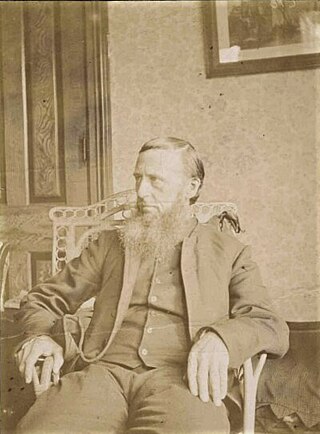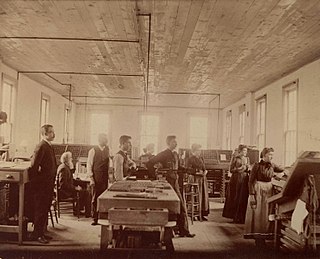Related Research Articles
Peace churches are Christian churches, groups or communities advocating Christian pacifism or Biblical nonresistance. The term historic peace churches refers specifically only to three church groups among pacifist churches:

Joseph Funk (1778–1862) was a pioneer American music teacher, publisher, and an early American composer. He invented a shape note system in 1851 for the Harmonia Sacra.
John A. Hostetler was an American author, educator, and scholar of Amish and Hutterite societies. Some of his works are still in print.

Abram Bowman Kolb (1862–1925): teacher and publisher; born 10 November 1862 near Berlin, Canada West, to Jacob Z. and Maria (Bowman) Kolb. Kolb is notable for editing Words of Cheer and Herald der Wahrheit. He also translated manuscripts including the Enchiridion of Anabaptist leader Dirk Philips, and Restitution by Henry Funk. He was the oldest son in a family of five sons and two daughters. On 3 January 1893, he married Phoebe Funk, the second daughter of John F. Funk. They had two daughters and two sons. Abram died 15 March 1925.

John Fretz Funk was a publisher and leader of the Mennonite Church. Funk published the Herald of Truth from 1864 until 1908 when it merged with the Gospel Witness to form the Gospel Herald. Jacob Clemens Kolb, in his preface to Bless the Lord, O My Soul quotes an unnamed commentator who said, "John F. Funk is the most important [Mennonite] man after Menno Simons."
The Mennonite Church USA Archives was founded in 2001 under the denominational merger of the (old) Mennonite Church and the General Conference Mennonite Church. Prior to 2001, the two largest Mennonite denominations maintained separate archives: the Archives of the Mennonite Church, located on the Goshen College campus, housed materials pertaining to the (old) Mennonite Church, while the Mennonite Library and Archives on the Bethel College campus held the records of the General Conference Mennonite Church.
John S. Coffman was a leader in the Mennonite Church in the late 19th century. He promoted evangelical and progressive reform through his positions in the Mennonite Publishing Company, revival meetings and chairmanship of the Elkhart Institute.

Prairie Street Mennonite Church is a Mennonite Church located in Elkhart, Indiana. It is a member of the Indiana-Michigan Mennonite Conference of Mennonite Church USA.
Yellow Creek Mennonite Church is a Mennonite Church located in Elkhart County, Indiana. It is a member of the LMC, a fellowship of Anabaptist churches.
Olive Mennonite Church is a Mennonite Church located just outside Wakarusa, Indiana, and a member of the Indiana-Michigan Mennonite Conference of Mennonite Church USA.
George Jay Lapp was an American missionary to India for the Mennonites. He was ordained in 1905 and became a Bishop in 1928 while in India. Lapp served as interim president of Goshen College from February 1918 until June 1919.

The Mennonite Publishing Company was a publishing agency in Elkhart, Indiana, operating primarily from 1875-1908, which under John F. Funk served as the main source of published material for the (old) Mennonite Church. The Mennonite Publishing Company was the third and final agency through which Funk published a great deal of historical and denominational Mennonite texts and periodicals, having previously published as "John F. Funk" from 1864-1869 and "John F. Funk and Brother" from 1869-1874.
The Mennonite Publication Board was founded in 1908 in Scottdale, Pennsylvania, as an organization through which the (old) Mennonite Church could own and operate its own publishing and periodicals. It served as the overseeing board for the printing and sale of denominational texts, operating the Mennonite Publishing House in Scottdale along with several bookstores throughout the United States and Canada, until 2002.
The Mennonite Publishing House was a non-profit publishing operation in Scottdale, Pennsylvania, controlled by the Mennonite Publication Board of the (old) Mennonite Church. It served as the primary publisher of the denomination's periodicals, books, and congregational materials from 1908 to 2002.
Heinrich Funck was a mill operator, religious author and a Mennonite bishop in America.
Daniel Brenneman was an influential Mennonite minister and modernizer of the Mennonite Church (MC), who later founded his own church.
John D. Kauffman was an Amish Mennonite minister and later bishop who preached while being in a state of trance and who was seen as a "sleeping preacher". The Kauffman Amish Mennonites, a group with about 3,500 members, still adhere to his teachings.
Gospel Herald was the official publication of the Mennonite Church from 1908–1998. It was formed from a merger of Gospel Witness and Herald of Truth. As part of the merger of the Mennonite Church and the General Conference Mennonite Church, Gospel Herald merged with The Mennonite of the General Conference Mennonite Church to form a new periodical titled The Mennonite.

John Horsch was a Mennonite historian and writer.
References
- ↑ "Heralds of Truth (Periodical)". Global Adventists Encyclopedia Online. Heralds of Truth Press. Retrieved 30 March 2024.
{{cite encyclopedia}}:|first=missing|last=(help); Unknown parameter|Last=ignored (|last=suggested) (help) - 1 2 3 Mishler, Dorsa (1996). The Prairie Street Mennonite Story: 1871-1996. Elkhart, IN: Mennonite Board of Missions. p. 98.
- 1 2 Gates, Helen Kolb, John Funk Kolb, Jacob Clemens Kolb, and Constance Kolb Sykes (1964). Bless the Lord O My Soul: A Biography of John Fretz Funk. Scottdale, PA: Herald Press.
{{cite book}}: CS1 maint: multiple names: authors list (link) - 1 2 Hostetler, John A. (1958). God Uses Ink. Scottdale, PA: Mennonite Publishing House.
- ↑ Juhnke, James C. (1989). Vision, Doctrine, War. Scottdale, PA: Herald Press. pp. 126–127.
- ↑ Stutzman, Karl. "Guides: Digital Mennonite Periodicals: About Digital Mennonite Periodicals". libraryguides.ambs.edu. Retrieved 2018-08-08.